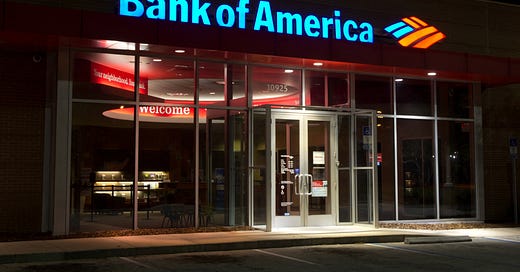Is a currently oversold Bank of America a buy in this market? Due Diligence
Spoiler: Bank of America is currently a solid value buy for a value investor
A Quick Bank of America Due Diligence Report-
Bank of America Overview:
Company: Bank of America Corporation (BAC)
Industry: Financial Services – Banking, Wealth Management, Investment Banking
Headquarters: Delaware, USA
Key Operations: A global leader in banking, serving 68 million clients with 3,900 branches, 16,000 ATMs, and 56 million digital users.
Stock: NYSE: BAC (currently oversold)
Bank of America Financial Performance
Latest financial data (Q4 2024):
Revenue:
2024: $192.434 billion (+11.94% from $171.912 billion in 2023)
2023: $171.912 billion (+49.42% from $115.053 billion in 2022)
2022: $115.053 billion
Net Income:
2024: $25.5 billion (+2.6%)
2023: $24.8 billion (-3.6%)
2022: $26 billion
Market Cap: ~$315 billion (at present time 3/7/25).
Current Stock Price: $41.46/share; down around 12% over the last month. Stock is currently in oversold territory with an ex-dividend date of 3/7/25 and a distribution date of 3/28/25 this could get more oversold in the coming couple of days.
Analysis: Bank of America’s revenue and income growth in 2024 reflects resilience amid inflation and rising rates.
Bank of America Risk Assessment
Interest Rate Risk: If yields rise, this may impact BAC’s bond portfolio, as seen in past cycles.
Regulatory Risks: Oversight by Federal Reserve, FDIC, and OCC, current administration seems favorable to large banking.
Economic Factors: Slow growth could pressure net interest income, offset by diverse revenue streams (e.g., wealth management).
Credit Ratings: Stable (Moody’s, S&P), supporting financial credibility.
Bank of America IRR Evaluation
The Internal Rate of Return (IRR) measures investment profitability. Here’s an IRR estimate for BAC stock:
Assumptions:
Timeframe: 5 years (2025–2029)
Initial Investment: $40/share (early 2025 stock price estimate)
Cash Flows:
Annual Dividend: $0.96/share (2024), growing 5%/year
Terminal Value: $50/share (2029, 5% annualized growth)
Projected Cash Flows:
Year 0: -$40 (investment)
Year 1: $0.96 (dividend)
Year 2: $1.01
Year 3: $1.06
Year 4: $1.11
Year 5: $51.17 ($1.17 dividend + $50 sale)
IRR Calculation:
Using NPV = 0 formula:
∑t=05CFt(1+IRR)t=0\sum_{t=0}^{5} \frac{CF_t}{(1 + IRR)^t} = 0 ∑t=05(1+IRR)tCFt=0
Approximate IRR ≈ 9.5% (via financial calculator or Excel).
Insights:
9.5% IRR: Competitive vs. 10-year Treasury (~4–5% in 2025).
Sensitivity: The IRR drops to 7.8% (still well above the 10-year) if the terminal value is $45; it rises to 11% at $55.
Discounted Cash Flow: My discounted cash flow analysis suggests Bank of America’s intrinsic value is approximately $59.55/share, approximately 30% upside from today’s price.
Bank of America Competitive Position
Peers: JPMorgan Chase, Citigroup
Strengths: Top-tier retail banking, digital innovation, and deposit growth.
Edge: Leader in sustainable finance and wealth management scale.
6. Conclusion: Bank of America Investment Outlook
Pros: Strong revenue, diversified operations, stable IRR of 9.5%. It also boasts a strong DCF analysis of 59.55/share.
Cons: Interest rate and regulatory risks.
Recommendation: Ideal for stable, moderate-return portfolios looking to get in at the current value price the stock is offering.





I generally find it hard to evaluate banks because banks operate by borrowing money (deposits and other forms of debt) and lending or investing it. They have highly leveraged balance sheets, typically employing significant amounts of debt relative to equity. Small errors or adjustments in assumptions about assets and liabilities can result in substantial swings in valuation, amplifying risks for investors. Nevertheless, investing in banks can still be highly rewarding—Warren Buffett’s success is a testament to this.